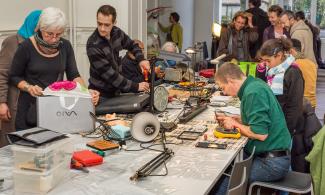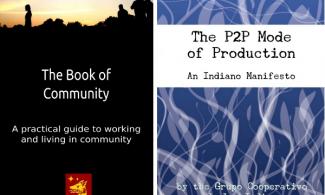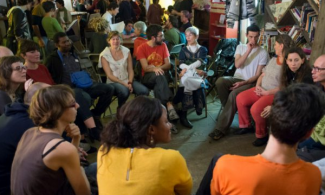
Originally published at Frontiers of Commoning and David Bollier's blog
Can creativity flourish and remain within the control of commoners? Or will businesses inevitably capture creativity and convert it into private property to make money?
Copyright and trademark law are certainly designed for those purposes. They presume a market identity for creators of art, software, and new knowledge. And in fact, the corporate world routinely vacuums up creativity that's developed through commoning – images, music, know-how, social sharing.
Yet history tells another story. It shows that creativity naturally thrives in commons, and need not enter the marketplace to find support or fruition. Commoning is an ideal vessel for the collaborative development of new ideas. The process may involve direct cooperation or merely proximate respect and influence, but in either case, introducing property rights and profit-making can seriously mess up the collective collaborations that yields innovation.
When I learned about Professor Aaron Perzanowski, a legal scholar at the University of Michigan Law School, I decided to quiz him about his work on my podcast, Frontiers of Commoning (Episode #45). I wanted to learn more about the bottom-up, social dynamics of creativity, how commoners sustain them, and the inevitable collisions with intellectual property law.
Perzanowski's 2017 anthology of essays, Creativity without Law, edited with Kate Darling, goes into great detail about this topic. The essays show that, contrary to the premises of intellectual property law, artists share. They come up with new ideas by working within a community of peers. They are not solo geniuses,but "nested-I's" working within a community.
Chefs constantly come up with new entrees and desserts even though they don't have copyright protection for recipes. Fashion designers dream up "new" and revamped dress designs all the time, and the industry flourishes, even though any garment can be copied by anyone. (It's the trademarked name that remains proprietary.)
Perzanowski and other law scholars have studied how creative communities actually function and flourish without copyright or trademark protection. These include people like tattoo artists, garment designers, chefs, street artists, and the prolific Nigerian film industry (whose business models don't rely on copyrights).
Comedians can't prevent others from telling their jokes or routines, but the comedy community does sometimes shame or look down on imitators who brazenly copies someone else's jokes without attribution. Street artists make their art in anonymity and without compensation (with exceptions such as Banksy and Keith Haring), if only because they don't own the buildings or surfaces on which their art is made.
While these examples may seem small and aberrational, the creative vitality of these communities suggests that the supposed boundaries between individual ownership and collective use can be far more open and porous than they are today. They don't need to be strictly patrolled. The only reasons that jazz, hip-hop, and rock have developed and stayed creatively vital is because their creativity has circulated freely. Newcomers can borrow and improve the canon with their own innovations. As for individual recognition and rewards, it turns out that social norms and reputation can be highly effective ways to honor individual creativity while disciplining those who rip off and steal. Picasso famously said, "Good artists copy. Great artists steal." It's entirely possible for markets and commons can play nicely with each other; markets just have to learn to be less greedy.
A logical extension of these ideas can be found in what I call repair commons. As Perzanowski explained:
"For anything that breaks in my house – the washing machine in my basement, the toilet that won't stop running in the bathroom – give me 30 seconds on YouTube and I will find someone who has a detailed, step-by-step process for fixing that particular model and that particular issue. You can go to the website IFixIt, which has a massive database of repair guides. Most of this stuff is created by users."
Perzanowski's 2022 book, The Right to Repair: Reclaiming the Things We Own, describes how clever, resourceful people are creating their own pools of knowledge and peer-support to help fix broken products. The makers of instructional videos, repair websites, guidebooks, and repair cafes are performing important services mostly outside of markets, at little or no cost.
At this point, this movement has reached a large enough scale – with people repairing their own motor vehicles, bicycles, electronics, household appliances, and more – that companies regard repair commons as a threat. For years, corporate manufacturers have been trying to suppress and criminalize the burgeoning "right to repair" movement by making repairs more difficult, expensive, or outright illegal.
For example, manufacturers often design products in ways that an ordinary consumer can't easily repair them. The idea is to stimulate the purchase of new products (and needless waste), which constitutes an advanced form of planned obsolescence. Or manufacturers design products so that replacement parts are expensive and proprietary; no inexpensive replacements or standard design specs are allowed.
Or manufacturers invoke copyright law to prohibit users from reverse-engineering software components in their cars, computers, or tractors to fix them. Only officially approved (and expensive) technicians can fix them. I find it amazing that companies are allowed to prohibit or prevent people from fixing products they legally bought and own. The waste, expense, inconvenience, and unfairness are maddening.
Fortunately, the "right to repair" movement has made serious headway in challenging the contrived obstacles to repair, and in winning legal rights for repair commons to exist. As Perzanowski explains, the movement has made some real progress in Europe, and more recently in California, when a landmark right-to-repair law was recently enacted. However, the right-to-repair ethic still faces formidable challenges. The great promise of repair-commoning remains unfulfilled.
For more on the repair movement, see the IFixit manifesto; The Maintainers website about DIY repair; the book Tools for Conviviality (1973), by Ivan Illich; and Aaron Perzanowski's books (see above).
Header image: Repair Café Ixelles, by #PhilippeCPhoto. CC BY-NC-SA 2.0





Add new comment